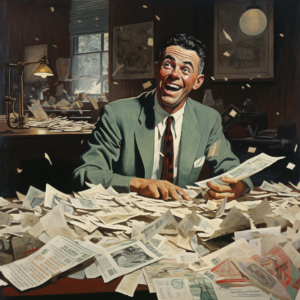Franchise economics are those in which a company’s product or service are:
- Needed or desired
- Considered to have no close substitute by customers
- Not subject to price regulation
If a company has all three of these characteristics it will demonstrate them by having the ability to regularly price its product or service aggressively and as a result generate high returns on capital.
These follow on characteristics are more carefully defined as follows:
- Pricing power – the ability to raise prices greater than or commensurate with the cost of inflation.
- Able to survive incapable management – profitability may be injured by poor management but demand side forces exist that are so strong that the business isn’t likely to fold before management issues are corrected. And, the business has an innate ability to supply the good or service at or near the quantity demanded by the market in spite of management.
The most common types of these businesses are some of the world’s most well-known brands. Think Nike, Coke, Cheetos, and Hershey’s. A ‘brand’ as such isn’t a necessary prerequisite. The characteristics of businesses with franchise economics are driven by the forces of microeconomics.
A few examples would likely include: The best knee surgeon in a big city, the only internet provider in a small town, and the furniture company with the biggest supplier network in the country. A company with a patent on the world’s most efficient solar panels may also qualify. Companies with natural or partial monopolies typically have all the characteristics of an economic franchise.
Companies that don’t exhibit these exact characteristics may not be terrible businesses. In fact, they might earn good returns on capital for extended periods of time. But, they may only earn exceptional profits as low-cost operators in a segment. Or temporarily, such as when supply is restricted. Driving up price competition.
Superior management may be able to guide business operations as a low-cost provider for an extended period of time. However, stiff competition and poor management will eventually do more harm to an average company than it will to an economic franchise.
It is broadly fair to divide the business world into two camps. Businesses with franchise economics and businesses without them.
Rather than expound upon well-known companies and why they are such great examples of franchise economics, we will instead compare examples of businesses that are (A) weak or partial examples of franchise business and (B) a well-run business (C) general businesses with no economic franchise characteristics.
It should be stated that simply because a business does not have franchise economics does not mean it cannot be profitable for owners or investors. Rather, over the long term, it is difficult for the company to be extremely profitable relative to a business with the characteristics of an economic franchise.
Example of weak or partial franchise businesses
A business can exhibit nearly all of the characteristics of a franchise business but fall just short of being one.
( As a brief side note. The author has had the honor of identifying, purchasing, and running one of these businesses for a number of years. )
Imagine the largest offshore software development services business in a small, lightly populated state in the US.
This software consulting business is able to provide US firms with access to the lowest cost, highest value software development labor available internationally. It has a business model that (A) is needed and desired and (B) has no close substitute [at a similar scale geographically] (C) and is not subject to price regulation.
Through quality service and superior training of its engineering staff, the company has become the largest provider of such services at the lowest cost in its geography. As a low-cost provider, the company remains healthy, growing rapidly in strong and recessionary markets. In addition to its ability to train exceptional engineers, the company has superior branding and marketing. Despite all of these wonderful characteristics, the company can never become an economic franchise. Why not?
The reason is twofold.
First, the company is a commodity business.
Even skilled labor like programming is a commodity. All else being equal, employers want to get their labor costs as low as possible without harming quality. As you might imagine, software development and maintenance is labor intensive and requires significant skill. For a business maintaining and continually developing critical software, tremendous value is had by building an in-house team to develop and maintain an application.
However, domestically, the United States is not producing enough trained engineers out of its universities to keep up with demand. The quantity demanded is higher than the available supply. The result is driving up local wages. Other countries, far more populous, have a greater supply of labor and not enough domestic demand, keeping their wages low. The natural result is that companies in the US can satiate their need for engineering resources only by looking internationally.
Due to the fact that a disproportionate share of the world’s population lives in the Asiatic regions, this supply and demand imbalance for labor will continue for a long time. At least until domestic demand for engineering labor is greater than its value internationally or some such change in the economics. This isn’t likely to occur for decades. But it will occur.
Second, the company can only exhibit very limited pricing power.
Structurally, there is also an artificial cap on what the company can charge for its labor. The company can’t charge more than the going rate for US resources. Prices can only rise to what the market will bear not above it.
Outside of a few specialized skills, which ultimately belong to the engineers, the company does not have the ability to continually price the majority of its services ahead of or well above inflationary forces, only at parity with them.
Over time, the company may fall victim to the broader effects of inflation on real wages. And, over the very long term, real wages in international markets will rise. As a result, the company will be squeezed by supply costs.
The business isn’t a bad business, in fact, it can remain very profitable for an extended period of time. At least as long as the business enjoys the microeconomic benefit of being the largest player in its region.
For the simple reason, the business cannot price its services aggressively and supply side forces will disrupt it in the future, the business does not exhibit characteristics of an economic franchise.
Example of a well-run business
The previous example of a near franchise was also an example of a well-run business. Businesses with or without franchise economics can be well-run businesses. And well-run businesses can have weak or partial franchise characteristics. Some businesses with weak franchise economics can strengthen their position and some well-run businesses can build capabilities that turn into franchise economics in their own right.
Perhaps the most common example of a well-run business that everyone should be familiar with is the best local restaurant in town.
- It’s not a necessity to visit a restaurant and may only be occasionally desired
- There are ample substitutes for restaurants
- It’s a given they are not subject to price regulation
It is often said that the person who works the hardest in a restaurant ends up owning it and the reasons are simple. Restaurants are capital-intensive with thin margins. To be the best restaurant in town requires a level of effort and quality superior to the competition to be sure. The results of being the best are more than likely positive financial outcomes. Well-run businesses may be able to develop many of the characteristics of a business with franchise economics. However, being the best restaurant in town does not make up for their fundamental deficits such as management and other economic deficits which may prevent them from compounding capital for prolonged periods of time.
The example of restaurants is raised as a particular example because franchise economics may bring to mind a restaurant franchise. These are separate and distinct concepts.
Restaurant Franchises, through the development of strong brands, a unique value proposition, and reputable service allow entrepreneurs to run individual establishments. Generally, these brands provide their wares in a homogeneous fashion across nearly every geography. The result is that they may be able to achieve many of the characteristics of an economic franchise.
Mcdonald’s, KFC, Dominos, Marriot International, Hertz Car Rentals, Kumon, and Hilton Hotels are all examples of well-run businesses that exhibit characteristics of franchise economics.
- They may be desired but rarely absolutely needed
- Many of these brands are substitutes for one another
- They are not generally subject to price regulation and can raise their prices slightly higher than their peers on account of their specialized goods and homogeneous quality across markets.
A local restaurant would need to develop similar characteristics, and unique products and processes. Management of the firm will also need to be less of a factor.
Any visitor to a poorly run restaurant knows implicitly that its prospects for global expansion are limited. That fact needs no further explanation.
Example of a general business with no economic franchise characteristics
This part of the market is typically characterized by businesses run with low-skilled labor and in some cases trade skills. Think pool cleaning, lawn maintenance, and certain home services. Distributors or trade businesses with no prospect of dominating their segment or any particular niche will also fall into this category.
For owners of such firms, small degrees of differentiation and specialization support or hinder relative degrees of profitability. Consumers in the aggregate benefited from the undifferentiated nature of these businesses because competition breeds better service at ever-lower prices. Owners and investors in such businesses will have to work harder than businesses with franchise economics.
The concept of franchise value
It is not enough to simply identify a business that exhibits all of the characteristics of an economic franchise. For a franchise to have enduring value its position in the market must be defensible for a very long period of time. It is not an indefinite requirement. An investor or manager must understand the nature and qualities of the business and if they are likely to be subject to life-threatening disruption and when.
Newspapers, phonebooks, travel agents, and publishers of yesteryear were mostly dealt a death blow by the advent of the internet. Some are still hanging on for dear life. For investors, in particular, the ability to compound capital without disruption is a real litmus test.
How much will the business need to change in the future to adapt to innovation? Will that innovation fundamentally alter what the business provides or how it is consumed? Will that help or hurt the economics of the company? The competition?
Long-term stock prices and earnings of the longest-lived firms suggest that the best business returns are usually achieved by companies operating in a similar manner over the previous five and ten-year periods. Obviously, management can’t sit on their laurels as opportunities to improve a business are generally endless. But a business facing constant change faces increased prospects for material human error.
Economic franchises with enduring franchise value typically have barriers to entry that are difficult to overcome by the competition. These may include but are not limited to:
- Patents and trademarks
- Exclusive governmental licenses or agreements
- Superior geographic footing
- Superior economics of scale and market share driven by consumer preference
An additional note about supply and demand. These advantages cannot be marginal or temporary as in the case of the example software services business which has near franchise economics. Supply and demand strengths must be sustainable and not subject to erosion to qualify. Finally, these competitive advantages by themselves are not enough to ensure ongoing franchise value.
For a detailed analysis of the characteristics exhibited by exceptional businesses see our post on “Reflections On Nature and Characteristics of Superior Businesses”.
Example of an economic franchise – Disney’s Franchise Value
Disney is a company with all the characteristics of an economic franchise exhibiting enduring franchise value. Disney has created a set of products that appeals to families and carries emotional appeal; it’s nearly the opposite of a commodity business.
Let’s break apart each of the characteristics of franchise economics and comment on the franchise value of the company.
(1) Needed or desired – Families want their children to share in the memories they themselves experienced as children.
“If you got the right kind of product, you may be paying for taste, you may be paying for a mental association that you have, or service availability. That’s franchise value, then the question is how durable and big is it? I’d say that franchise is basically like a moat around your economic castle.”
– Warren Buffett
(2) Considered to have no close substitute by customers – the company owns the intellectual property for the characters and intellectual property it creates. This perpetual ownership creates impassable barriers to entry, after all, there is only one Mickey mouse.
(3) Not subject to price regulation – there is no reason to regulate Disney’s fiefdom. The company continues to exhibit pricing power and the ability to compound capital at high rates of return.
Pricing Power – Nearly every year, Disney is able to raise the price of entry to its parks, increase ticket prices to see its films, and charge more for merchandise.
High return on incremental capital and asset-light– Disney’s production of new assets is not particularly capital intensive and the media distribution channels available to the company are increasingly affordable to leverage.
Disney’s franchise value is defensible.
Durable competitive advantage. – Disney’s business is simple. They produce creative and entertaining stories to which they own the IP in perpetuity. Because of the captive nature of possessing all the rights to the characters tied to the brand, there is no substitute for those characters or visiting Disneyland. The company has an absolute monopoly on its intellectual property.
Economics of scale – The company is able to expand its empire with the acquisition of other brands like Star Wars and Marvel. The scale of its media empire plays into its ability to insulate itself from the competition by buying the best intellectual property available in addition to creating it in-house.
Demand –
- The company has grown over the better course of a century.
- The content can be consumed over and over again by children and young adults.
- No shortage of demand for entertainment.
- Each ‘micro brand’ is extensible. Peter Pan has sequels and spinoffs ranging from additional movies and tv shows to video games. People only want to consume more of a given universe.
- Just as exportable and American as Coca-cola.
These combined characteristics keep Disney in a class of its own and likely will continue to do so for some time.
A review of how management factors into the equation
Markets can become irrational and stay that way for extended periods of time. An investor cannot rely for all time on the market’s recognition of the innate value of a firm. Superior management can protect value in adverse market conditions.
As we have previously established, even non-franchise businesses run by superior management can produce excellent returns. In light of adverse market conditions. Investment in superior managers may aid in the reallocation of capital towards more productive assets that are temporarily out of favor and selling at a discount.
Takeaways for investors and managers
Many investors assume incorrectly that a brand name company is a franchise. It is the combination of factors previously mentioned from which an economic franchise can emerge. Real earnings must also support this thesis in time.
The skill of identifying franchise value must be developed. As should the opportunity cost of understanding and comparing the prospects of various economic franchises. Markets may not always offer the opportunity to purchase companies like Disney at prices attractive enough to justify a sufficient return.
Yet, defensible economic franchises may present opportunities for superior returns for investors. This may be due in part to the way that they insulate returns from human error and competition. Investors must judge such opportunities on a continuum among other available opportunities.
Exceptional managers can also emerge among near franchise businesses overshadow even the most enduring firms. In a horse race, jockeys and horses have the ability to influence outcomes as much as external factors. Identifying the best managers and business with economic characteristics are a critical step to finding value in the market.
The implication for managers allocating capital or building businesses is to understand the forces at work among the best competitors.




